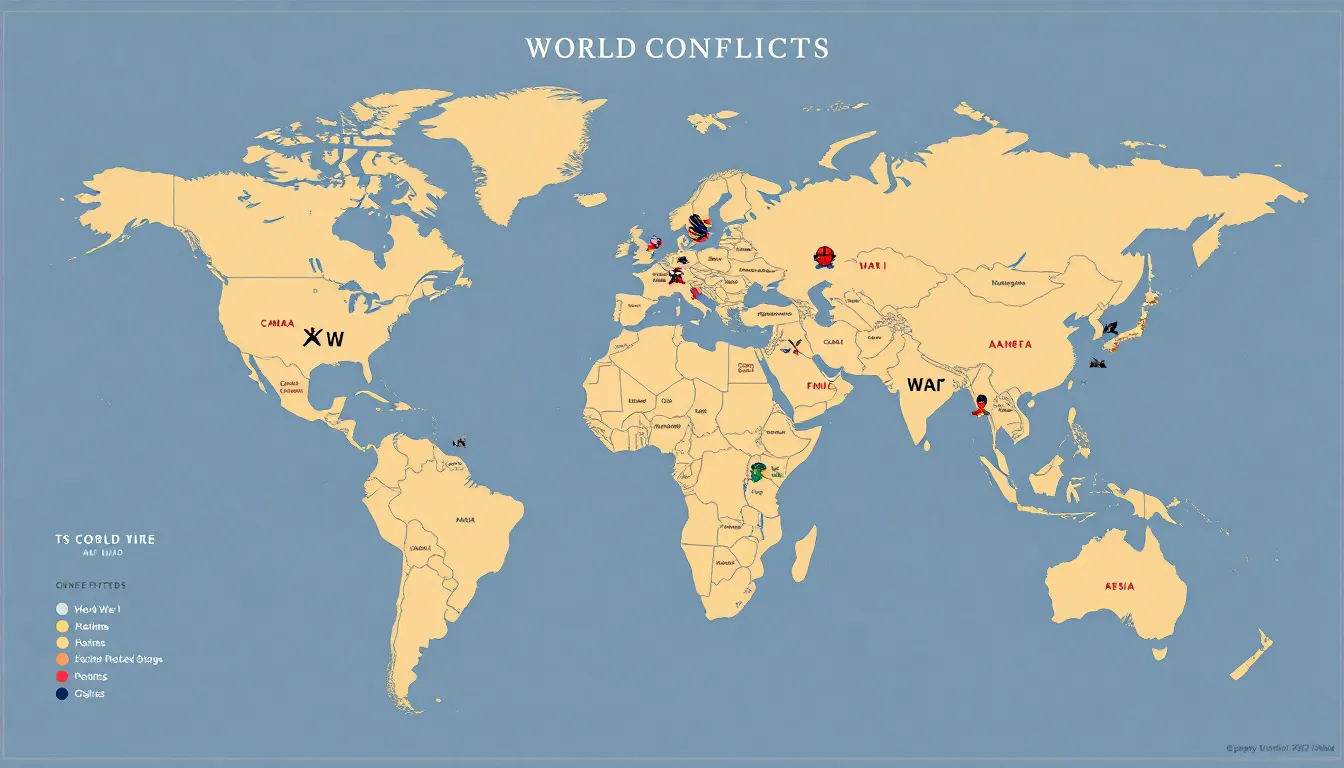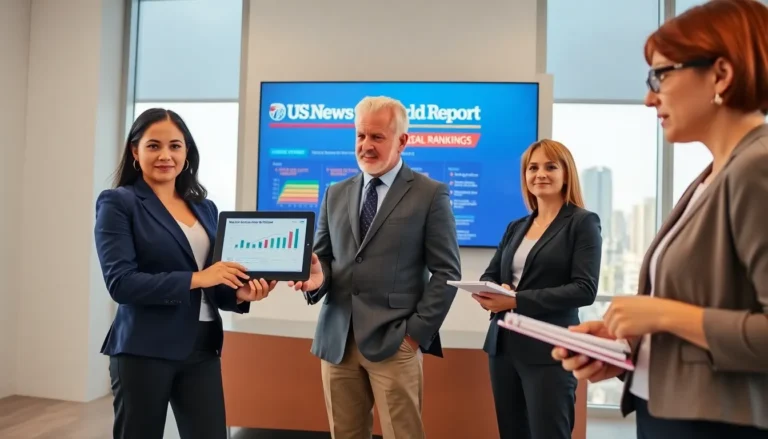World conflicts might seem like an endless soap opera, filled with plot twists and unexpected character developments. From territorial disputes to ideological clashes, these conflicts shape the course of history and impact millions of lives. Just when you think the drama’s over, another episode springs to life, reminding everyone that peace is often just a temporary truce.
But don’t worry; this isn’t just a gloomy tale of strife and turmoil. Understanding these conflicts can be enlightening, revealing the complexities of human behavior and the intricacies of global relations. Buckle up as we dive into the fascinating world of conflicts—where the stakes are high, the players are numerous, and the lessons are invaluable. Get ready to explore the battlefield of ideas and motivations that drive nations to confront one another.
Table of Contents
ToggleOverview of World Conflicts
World conflicts manifest through various forms, including territorial disputes, ideological struggles, and civil wars. These confrontations affect millions of people globally, driving significant shifts in political and social landscapes. Historical patterns often reveal underlying motivations that fuel these disputes.
In today’s landscape, major conflicts include the Syrian civil war and tensions in the South China Sea. Each situation highlights unique factors, such as resource competition or ethnic divisions. Understanding these complexities aids in comprehending broader geopolitical strategies.
Various organizations track and analyze conflicts. For instance, the United Nations Peacekeeping operates in numerous regions, attempting to stabilize areas in turmoil. Local governments may also play pivotal roles, influencing both resolutions and escalations.
The impact of world conflicts extends beyond immediate casualties. Economic consequences can destabilize entire regions, leading to refugee crises and humanitarian needs. Nations directly involved often experience shifts in policy and public sentiment due to ongoing violence.
International responses vary significantly. Some countries engage diplomatically, while others resort to military interventions. Global alliances also shape responses, as seen with NATO and its collective security approach.
Historical lessons emphasize the importance of dialogue and negotiation. Previous conflicts suggest that prolonged violence fails to yield lasting peace, often resulting in cycles of retaliation. Moving forward, fostering understanding is essential to mitigate future disputes.
This interplay among various factors demonstrates that conflicts are multifaceted and require nuanced approaches for resolution. Addressing root causes remains vital for any sustainable solution, highlighting lessons that humanity must learn from history’s confrontations.
Historical Context

World conflicts have deep historical roots, shaping nations and societies over time. Understanding these conflicts requires examining key events and patterns that continue to influence today’s geopolitical landscape.
Major Conflicts of the 20th Century
World War I and World War II stand as pivotal moments in the 20th century, both resulting in massive loss of life and significant political shifts. The Cold War further intensified ideological rivalries, leading to numerous proxy wars in regions like Korea and Vietnam. Decolonization movements emerged, causing conflict as nations sought independence from colonial rule. Conflicts in Africa, such as the Rwandan Genocide, highlighted the devastating consequences of ethnic tensions and colonial legacies. These historical conflict patterns laid the groundwork for contemporary disputes.
Post-Cold War Conflicts
The end of the Cold War shifted global dynamics, giving rise to new conflicts shaped by nationalism and ethnic strife. Conflicts in the Balkans during the 1990s highlighted the fragility of regional stability. The rise of terrorism, notably exemplified by the September 11 attacks, ignited military interventions in Afghanistan and Iraq. Complex factors, including resource competition in the Middle East, continue to exacerbate tensions further. Global responses have varied, reflecting a mix of diplomatic efforts and military actions aimed at addressing these emerging crises.
Current World Conflicts
Current global conflicts reflect complex historical and social dynamics. Various issues fuel these ongoing struggles.
Ongoing Conflicts and Their Causes
Conflicts persist in regions like Syria, Ukraine, and Yemen. In Syria, civil war stems from a mix of political repression and ethnic tensions. Competing geopolitical interests complicate the situation further. Meanwhile, the Ukraine conflict involves territorial disputes and significant economic implications. Yemen faces one of the world’s worst humanitarian crises, deeply rooted in political instability and foreign intervention. Each conflict illustrates how historical grievances and resource competition shape modern environments.
Impact on Global Stability
Global stability hinges on the resolution of these conflicts. Displaced populations from war zones create refugee crises that strain neighboring countries. Economic repercussions reverberate worldwide as trade routes and markets become disrupted. Nations increasingly respond with military interventions or sanctions, escalating tensions. Organizations like the United Nations facilitate dialogue to promote peace, though effectiveness varies. Maintaining security in affected regions translates into a broader impact on international relations and cooperation.
The Role of International Organizations
International organizations play a crucial role in addressing world conflicts. Their efforts range from peacekeeping missions to implementing conflict resolution strategies that foster long-term stability.
Peacekeeping Efforts
United Nations Peacekeeping missions stabilize regions experiencing conflict. These missions often deploy troops from multiple countries to help maintain ceasefires. Troops act as neutral parties, facilitating dialogue between conflicting groups. Past operations in countries like Bosnia and Rwanda demonstrate the significance of international presence in preventing escalation. Success hinges on collaboration among nations and effective mandate implementation. Troops assist in rebuilding infrastructure and supporting humanitarian efforts, contributing to community resilience. Lack of resources can hinder mission effectiveness, necessitating sustained global support.
Conflict Resolution Strategies
International organizations employ various conflict resolution strategies to promote understanding. Diplomatic engagement prioritizes dialogue, seeking to mediate disputes before they escalate. Negotiating peace agreements often involves multiple stakeholders, including governments and non-governmental organizations. Education initiatives foster cultural exchange, reducing misunderstandings among conflicting parties. Specialized bodies, such as the Organization for Security and Co-operation in Europe, work to address issues through diplomatic channels. They assess conflicts, recommend solutions, and advocate for sustainable peace. Long-term success relies on addressing underlying grievances that fuel tensions, requiring persistent effort and cooperation.
Understanding world conflicts is essential for grasping the complexities of human interactions and global relations. Each conflict is a reflection of deep-rooted historical grievances and social dynamics that continue to shape our world today. As nations grapple with the consequences of these confrontations, the importance of dialogue and cooperation becomes increasingly clear.
Efforts to resolve conflicts through diplomacy and international collaboration are vital for achieving lasting peace. The role of organizations like the United Nations remains crucial in stabilizing regions and fostering understanding among conflicting parties. By learning from the past and addressing the underlying causes of disputes, humanity can work towards a more peaceful and stable future.





